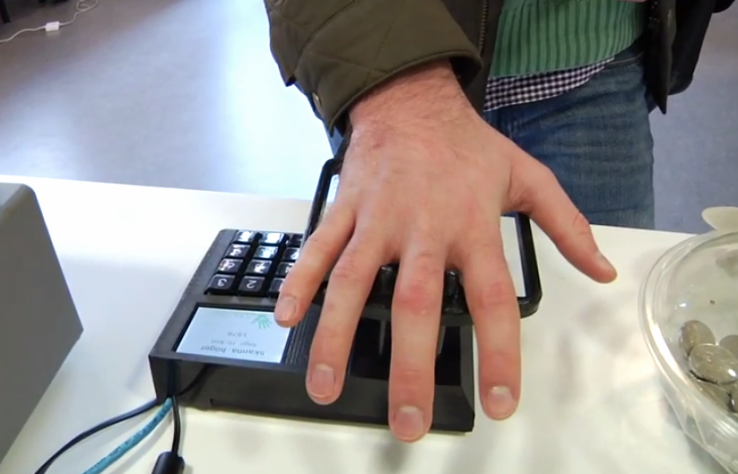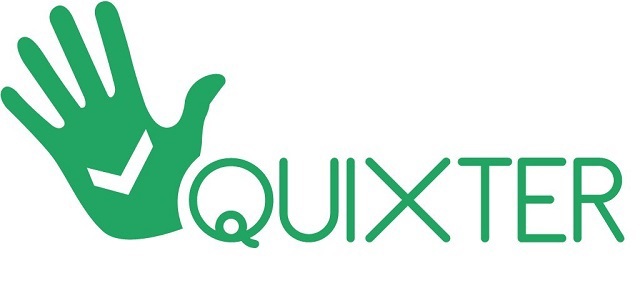Quixter's new Pay-By-Palm biometric electronic payment technology scans the veins of your palms.
Non-cash payments using an NFC -enabled phone are a common means of payment. However, today there is another, alternative and simplified technology for electronic payments - a biometric identifier. This system uses the user's palm to make the payment, or rather the configuration of the veins in the palm of the hand.

The author of the Swedish startup Quixter is an engineering student at Lund University, Fredrik Leifland, who wanted to come up with a faster system for making card payments, without having to carry around a lot of cards and everything else.
')
Quixter uses the palm vein configuration technology to identify the person making the payment. This technology is based on the unique configuration of the veins of each person to which the bank account is attached. “We are currently working with all the major Swedish banks,” says Leifland.

By itself, the technology of scanning the veins of the palm is not new. For several years now, it has been used in ATMs of Japanese banks (as well as other countries) as a way of providing additional security for large transactions. However, Leyfland argues that his idea is an innovation in the market, since no one has yet launched the payment system using the user's palm. Many companies seek to develop a similar technology, but so far there is none on the market.
In essence, the advantage of Quixter's palm scanning system is that it allows you to make a payment without the need for a user of physical money or payment cards, as well as an NFC phone.
The second advantage of the system is security. According to Leyfland, with such a system it is impossible to commit fraud, not counting, of course, cases when you can force someone to buy something by forcibly placing his palm on the identifier.
So far it is a controversial question whether the Quixter palm scanning system is faster than making credit or debit card payments, as this system also asks the user to enter the last four digits of their phone number and then put a hand to the terminal to scan. So, this is not a one-step payment process.
However, the digits of the phone number were apparently added in part to slow down the process, so that the user had time to see how much he was paying - in order to avoid overpayment before the user realized that he was being robbed.
Quixter currently operates at about 15 locations on the campus of the University of Lund and serves about 1,600 users (mostly students).
As in the case of NFC, a significant number of retail transactions will be required to enter the mass market of a payment system using a palm. Therefore, targeting small communities, like university campuses, is entirely appropriate. However, it is possible that the deployment of the system may occur in the short term.
If you want to be the first to learn about the latest medical and fitness gadgets, follow the company news, subscribe to our pages on social networks. You can subscribe to our blog page , Twitter , join our group in
Twitter , join our group in  Vkontakte and in
Vkontakte and in  Facebook New gadgets and fitness devices in our online store Medgadgets.ru .
Facebook New gadgets and fitness devices in our online store Medgadgets.ru .

The author of the Swedish startup Quixter is an engineering student at Lund University, Fredrik Leifland, who wanted to come up with a faster system for making card payments, without having to carry around a lot of cards and everything else.
')
Quixter uses the palm vein configuration technology to identify the person making the payment. This technology is based on the unique configuration of the veins of each person to which the bank account is attached. “We are currently working with all the major Swedish banks,” says Leifland.

By itself, the technology of scanning the veins of the palm is not new. For several years now, it has been used in ATMs of Japanese banks (as well as other countries) as a way of providing additional security for large transactions. However, Leyfland argues that his idea is an innovation in the market, since no one has yet launched the payment system using the user's palm. Many companies seek to develop a similar technology, but so far there is none on the market.
In essence, the advantage of Quixter's palm scanning system is that it allows you to make a payment without the need for a user of physical money or payment cards, as well as an NFC phone.
The second advantage of the system is security. According to Leyfland, with such a system it is impossible to commit fraud, not counting, of course, cases when you can force someone to buy something by forcibly placing his palm on the identifier.
So far it is a controversial question whether the Quixter palm scanning system is faster than making credit or debit card payments, as this system also asks the user to enter the last four digits of their phone number and then put a hand to the terminal to scan. So, this is not a one-step payment process.
However, the digits of the phone number were apparently added in part to slow down the process, so that the user had time to see how much he was paying - in order to avoid overpayment before the user realized that he was being robbed.
Quixter currently operates at about 15 locations on the campus of the University of Lund and serves about 1,600 users (mostly students).
As in the case of NFC, a significant number of retail transactions will be required to enter the mass market of a payment system using a palm. Therefore, targeting small communities, like university campuses, is entirely appropriate. However, it is possible that the deployment of the system may occur in the short term.
If you want to be the first to learn about the latest medical and fitness gadgets, follow the company news, subscribe to our pages on social networks. You can subscribe to our blog page ,
 Twitter , join our group in
Twitter , join our group in  Vkontakte and in
Vkontakte and in  Facebook New gadgets and fitness devices in our online store Medgadgets.ru .
Facebook New gadgets and fitness devices in our online store Medgadgets.ru .Source: https://habr.com/ru/post/220107/
All Articles